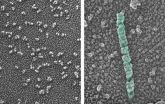(Press-News.org) Los Angeles, (July 2011) — Despite helping to push Hosni Mubarak and his regime from power, Egypt's liberals and pro-democracy activists are having trouble moving from revolution to politics, according to a recent article in the World Policy Journal (published by SAGE).
In this in-depth look at the Egyptian political landscape, the article's author, Jenna Krasjeki, examines various groups vying for influence and public support in the run-up to elections this fall. One common characteristic that Krasjeski notes is the lack of organization in the groups of young, liberal Egyptians who helped serve as catalysts to the protests in Tahrir Square.
"Was it possible that they had enough power to topple Mubarak, but not enough to avoid being pushed aside in the new Egypt?" Krasjeki writes. "Secular-democrats and liberals are scrambling to organize. The result has been an amorphous array of organizations and parties, each trying to define a platform and identify leaders to sell it to the Egyptian public."
One challenge the youth activists face is the need to expand their grassroots support beyond the educated middle class in Cairo. While many of them were successful while concentrating their activities in Cairo and using social media, such as Facebook, to help spur street demonstrations, those tools are proving less effective in wide swaths of rural Egypt, where access to the Internet is limited. In the meantime, other groups, such as the Muslim Brotherhood and the remnants of Mubarak's National Democratic Party, are using their political experience and organizational abilities to sway Egyptian voters.
###
Krasjeki also reports on the current military government's uncertain commitment to democratic reform in the article, "Beyond Tahrir Square," in World Policy Journal. The article is available free for a limited time at: http://wpj.sagepub.com/content/28/2/89.full.pdf+html .
World Policy Journal, founded in 1983, is the flagship publication of the World Policy Institute, a leading global think tank. The Journal publishes lively, intelligent writing from both distinguished and emerging thinkers around the globe, challenging conventional wisdom and offering new perspectives on crucial world issues. Covering such issues as geopolitical and economic shifts, global security, conflict and peace building, immigration, resource scarcity, and cultural and social change, the journal is read by policy and thought leaders at the highest levels. http://wpj.sagepub.com
The World Policy Institute, a non-partisan global think tank based in New York City since 1961, engages fresh ideas and new voices from around the world to address critical shared challenges. Through policy analysis and public debate, it seeks and promotes cooperative policy solutions in support of an inclusive and sustainable global market economy, effective and fair global governance, and collaborative approaches to security. www.worldpolicy.org
SAGE is a leading international publisher of journals, books, and electronic media for academic, educational, and professional markets. Since 1965, SAGE has helped inform and educate a global community of scholars, practitioners, researchers, and students spanning a wide range of subject areas including business, humanities, social sciences, and science, technology, and medicine. An independent company, SAGE has principal offices in Los Angeles, London, New Delhi, Singapore and Washington DC. www.sagepublications.com
END
A simple cut to the skin unleashes a complex cascade of chemistry to stem the flow of blood. Now, scientists at Washington University School of Medicine in St. Louis have used evolutionary clues to reveal how a key clotting protein assembles. The finding sheds new light on common bleeding disorders.
The long tube-shaped protein with a vital role in blood clotting is called von Willebrand Factor (VWF). Made in cells that form the inner lining of blood vessels, VWF circulates in the blood seeking out sites of injury. When it finds them, its helical tube unfurls to catch ...
Flooding along the Missouri River continues as shown in recent Landsat satellite images of the Nebraska and Iowa border. Heavy rains and snowmelt have caused the river to remain above flood stage for an extended period.
A Landsat 5 image of the area from May 5, 2011 shows normal flow. In contrast, a Landsat 7 image from July 17 depicts flood conditions in the same location.
A national overview map of streamflow provided by U.S. Geological Survey (USGS) WaterWatch graphically portrays the immense geographic extent of flooding in the Missouri River basin.
Monitoring ...
In the fight to improve global health, alleviate hunger, raise living standards and empower women in the developing world, chickens have an important role to play.
Jagdev Sharma, a researcher at the Center for Infectious Diseases and Vaccinology at Arizona State University's Biodesign Institute has been investigating the advantages of a more productive species of chicken for villagers in rural Uganda. He reports his findings this week at the American Veterinary Medical Association Meeting in Saint Louis, Missouri.
The star of this developing story is a type of chicken ...
Scientists of the CDF collaboration at the Department of Energy's Fermi National Accelerator Laboratory announced the observation of a new particle, the neutral Xi-sub-b. This particle contains three quarks: a strange quark, an up quark and a bottom quark (s-u-b). While its existence was predicted by the Standard Model, the observation of the neutral Xi-sub-b is significant because it strengthens our understanding of how quarks form matter. Fermilab physicist Pat Lukens, a member of the CDF collaboration, presented the discovery at Fermilab on Wednesday, July 20.
The ...
The GOES-13 satellite captured a triple-header in the tropics today when it captured three tropical cyclones in one image in the Northern Hemisphere.
A visible image taken from the GOES-13 satellite on July 20 at 14:45 UTC (10:45 a.m. EDT) and shows a consolidating low pressure area called System 99L in the eastern North Atlantic Ocean, Tropical Storm Bret several hundred miles east of South Carolina, and a large Hurricane Dora off the west coast of Mexico. The image was created by the NASA/NOAA GOES Project at NASA's Goddard Space Flight Center in Greenbelt, Md.
System ...
Birds use their bills largely to forage and eat, and these behaviors strongly influence the shape and size of a bird's bill. But the bill can play an important role in regulating the bird's body temperature by acting as a radiator for excess heat. A team of scientists have found that because of this, high summer temperatures have been a strong influence in determining bill size in some birds, particularly species of sparrows that favor salt marshes. The team's findings are published in the scientific journal Ecography, July 20.
Scientists at the Smithsonian Migratory ...
Take a second look at your iced or steaming tea. Guided by scientific experts, three New York City high school students using tabletop DNA technologies found several herbal brews and a few brands of tea contain ingredients unlisted on the manufacturers' package.
The teen sleuths also demonstrated new-to-science genetic variation between broad-leaf teas from exported from India versus small-leaf teas exported from China.
Guided by DNA "barcoding" experts at The Rockefeller University, an ethno-botanist at Tufts University and a molecular botany expert at The New York ...
Two-thirds of people with severe and otherwise untreatable epilepsy were completely cured of their frequent seizures after undergoing neurosurgery at the University of California, San Francisco Medical Center, according to a new study that examined 143 of these patients two years after their operations.
The new study not only shows the promise of this type of neurosurgery at treating severe epilepsy, it also highlights how research into brain imaging may help to further improve results for people who have such operations.
"Surgery can be a powerful way to stop this ...
July 20, 2011 – BGI (previously known as the Beijing Genomics Institute), the largest genomics organization in the world, and Kunming Institute of Zoology, Chinese Academy of Sciences, together published the whole sequence variation map of rhesus macaque (Macaca mulatta) in Genome Biology on July 6th, 2011 (http://genomebiology.com/2011/12/7/R63). The study provides available resources for evolutionary and biomedical research.
Rhesus macaque, also called the Rhesus monkey, is one of the best known species of old world monkeys. Human and Rhesus macaque share a most recent ...
LOS ANGELES (July 20, 2011) –Neurologist Michele Tagliati, MD, director of the Movement Disorders Program at Cedars-Sinai Medical Center, served on an elite international task force commissioned by the Movement Disorder Society to provide insights and guidance on deep brain stimulation for dystonia, an uncommon condition that causes sustained, sometimes crippling muscle contractions.
The resulting articles, describing the data reviewed and outlining the group's conclusions, recommendations and points to be addressed in future research, published online last month in ...






